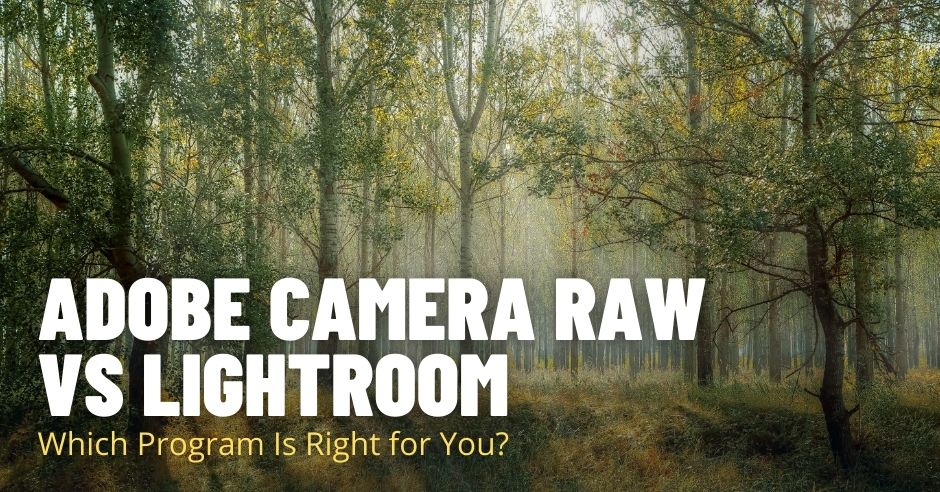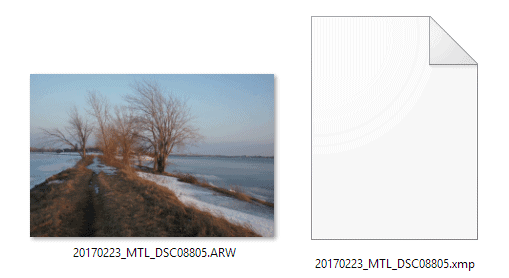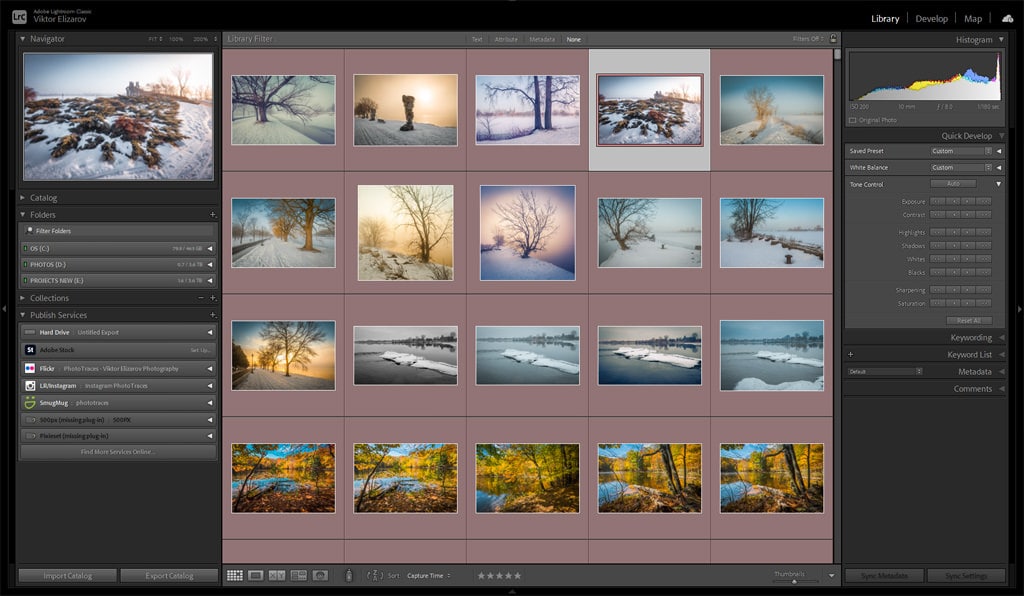Which program is best, Adobe Camera Raw vs Lightroom? And which should you use for your photography workflow?
In this article, I’m going to share a thorough comparison of these two programs. I’ll discuss all the key features, from editing capabilities and file types to digital asset management and integration.
By the time you’re done, you’ll know which program is right for you – and I’ll even explain how you can effectively integrate both programs into your editing workflow.

Let’s get started.
What Is Adobe Camera Raw?
Adobe Camera Raw (ACR) is a RAW file converter. It turns a RAW file into a more flexible file type, such as a TIFF, JPEG, or even a PSD – so that you can easily preview, share, or edit your work.
ACR began as a Photoshop plugin, allowing photographers to open RAW files, convert them in Camera Raw, then continue with editing in Photoshop. But it soon became a permanent fixture of the Photoshop environment (way back in 2003, when Adobe first released Photoshop CS).
Since then, Camera Raw has gone through plenty of iterations. Today, it offers hundreds of editing options, including basic exposure adjustments, basic color adjustments, and targeted (local) adjustments via brushes and filters. While ACR can’t match the expansiveness and depth of Photoshop, and while it’s technically still a Photoshop plugin, it now packs the power of a standalone editor.

What Is Lightroom?
Lightroom is an image editing and digital asset management (DAM) program offered by Adobe.
Unlike Adobe Camera Raw, Lightroom is split into several modules, each with a designated function. For instance, you get an image library (for importing and organizing images), a Develop module (for making edits), a Print module (for preparing images for print), and more.
Lightroom was originally labeled “Photoshop Lightroom,” with the goal of high-volume image processing that just wasn’t possible in Photoshop. Note that Lightroom’s developers took the (already existing) Adobe Camera Raw and stuck it into Lightroom’s Develop module – so the editing features in both programs are functionally identical, with the same sliders, the same adjustment tools, and as of the most recent major update, a similar editing layout.
In other words:
When it comes to editing, ACR and Lightroom are essentially the same program.

That said, there are some important differences, especially when it comes to workflow and digital asset management (and I discuss these in depth below).
The Advantage of Nondestructive RAW Editing
Both Camera Raw and Lightroom are nondestructive RAW editors, which means they adjust RAW files without overwriting the original image.
So if you increase the exposure in ACR or Lightroom, you’re not actually brightening the original pixels; instead, you’re writing the changes to an image catalog (Lightroom) or to a sidecar file (ACR).

The original RAW image always stays untouched.
Why is this important?
It means that you can make as many changes as you want to your files, yet you’ll never destroy the original. Everything is reversible. If your tastes change or you make a mistake, you can always reset the edits and start over.
Also, ACR and Lightroom (including Lightroom Classic, Lightroom, and Lightroom Mobile) all recognize one another’s catalogs and sidecar files – so you can edit in one program, switch to another, and head into a third with complete continuity.
And because ACR and Lightroom presets are the same, you can import any Lightroom presets into ACR and vice versa.
What Are the Advantages of Lightroom?
As I explained above, Lightroom and ACR offer identical editing packages.
But Lightroom offers a level of functionality on top of its editing:
Digital asset management.
In Lightroom, you can import files of all types (including both RAWs and JPEGs), then you can organize them into different collections, give them keywords, ratings, flags, and much, much more. And after organizing, you can move into the Develop module to make edits, then back into the Library module for further organization, and so on.

This is a huge deal. It’s a way to keep the entire photographic workflow – from organization to editing to exporting – in one place, and this is invaluable for beginners, enthusiasts, and professionals. Plus, Lightroom isn’t just a digital asset management program, it’s the digital asset management program, one that outperforms most of the other options on the market and is used by plenty of world-class professionals.
Compare this to Adobe Camera Raw, which includes zero organization capabilities. You click to open a file, you edit the file in ACR, and you save it, export it, or continue on to Photoshop. There’s no organizing images into folders or collections or anything else. (You can add a star rating, but it’s not especially useful unless you use Adobe Bridge, discussed below.)
What Are the Advantages of Adobe Camera Raw?
As you’re now aware, Adobe Camera Raw is mostly just a portion of Lightroom that converts files for Photoshop.
But this does come with some benefits.
For one, ACR doesn’t use a catalog; image edits are stored alongside the original RAW file. This can be useful if you want to share RAW files with another computer – instead of sending your RAW file plus the whole Lightroom catalog, you can just send the RAW file and the sidecar file (which is conveniently located right next to the original RAW).
(You can make Lightroom do this, but it takes some setup, plus it takes up additional storage space.)
And two:
Adobe Camera Raw is made for Photoshop, so it’s incredibly easy to start in ACR, do some editing in Photoshop, and then (via Adobe’s Camera Raw filter) make additional changes in Camera Raw.
Yes, Lightroom does offer Photoshop integration. But it’s not nearly as convenient as the ACR-Photoshop workflow, so for those who plan to spend lots of time in Photoshop, ACR is very appealing.
Camera RAW + Bridge vs Lightroom
For those of you who like Adobe Camera Raw but are frustrated by the lack of DAM capabilities, there is a solution:
Adobe Bridge.
Bridge was released back in 2005, and it’s just an image organizer – so it can act as the DAM companion to ACR’s editing.
For photographers who prefer not to use Lightroom, Adobe Bridge is a lifesaver. You can organize images in Bridge, then do RAW conversions and basic edits in Adobe Camera Raw before making major adjustments in Photoshop.
Plus, Adobe Bridge is a photo organizing program that is completely free.

How to Use Lightroom and Camera Raw Effectively
Adobe Bridge is great – but what if you want to stick with Lightroom for image organization, but you also want to be able to access Adobe Camera Raw? What do you do?
You can combine ACR and Lightroom through a handy little workflow:
First, you import and organize your images in Lightroom.
Then, you can make basic adjustments in the Lightroom Develop module.
Once you’re ready to do higher-level adjustments, you can right-click on an image and select Edit In > Open as Smart Object in Photoshop.

Your file will open in Photoshop. You can make any Photoshop adjustments you like. And you can also use the Camera Raw filter, which lets you access ACR within the Photoshop interface.
Adobe Camera Raw vs Lightroom: Conclusion
Adobe Camera Raw and Lightroom are both excellent programs. The key is to determine which one works for you.
If you spend most of your time in Photoshop, ACR (plus Bridge) might be the better choice. But if you prefer Lightroom’s editing and organization capabilities, you can always work effectively with Lightroom and Photoshop – and, when you need it, the Camera Raw filter!

